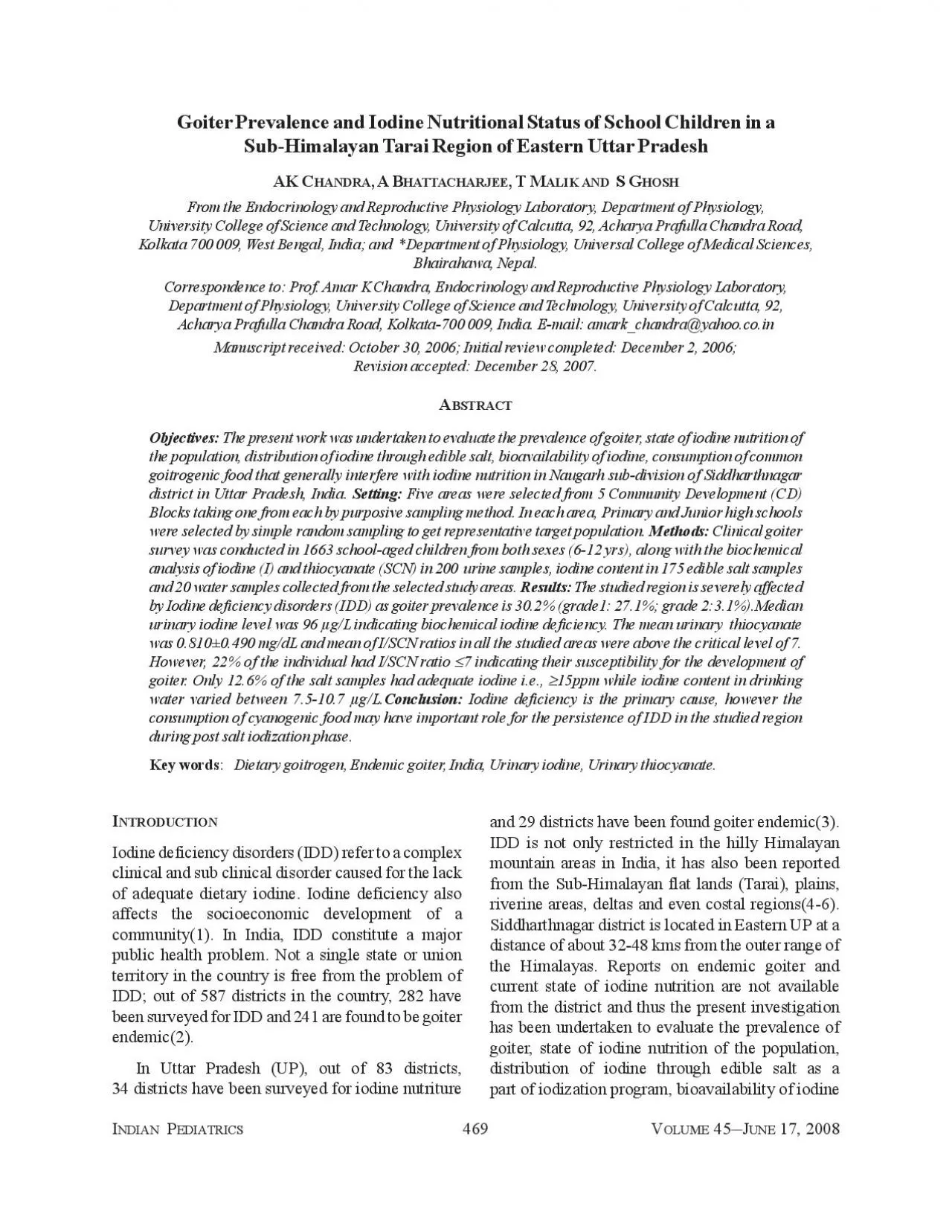

UP470V 45 17 2008Study on Goiter PrevalenceSelection of study areawhich 10 are rural and 4 are urban The present studyconsists of 5 CD Block 1 urban 4 rural To getadequate representative target ID: 958966
Download Pdf The PPT/PDF document "Goiter Prevalence and Iodine Nutritional..." is the property of its rightful owner. Permission is granted to download and print the materials on this web site for personal, non-commercial use only, and to display it on your personal computer provided you do not modify the materials and that you retain all copyright notices contained in the materials. By downloading content from our website, you accept the terms of this agreement.
Goiter Prevalence and Iodine Nutritional Status of School Children in aSub-Himalayan Tarai Region of Eastern Uttar Pradesh, A BHATTACHARJEE, T M S G UP470V 45 17, 2008Study on Goiter PrevalenceSelection of study areawhich 10 are rural and 4 are urban. The present studyconsists of 5 CD Block (1 urban, 4 rural). To getadequate representative target population for goitersurvey.Selection of target population: recommendation of WHO/UNICEF/ICCIDD(8), thevulnerability to goiter, easy accessibility and becausethey are representative of their age group in thecommunity(8). As there is no adequate informationof 20% and allowable/permissible error of 10%. Asample size of 1600 was obtained. A total of 1663 All the students of thethe enlargement of thyroid (goiter) by trainedrecommended criteria of WHO/UNICEF/ICCIDDWHO/UNICEF/ICCIDDvisible; Grade 2: thyroid visible with neck in normalposition](8). The age of the examined students wasoff to the nearest whole number.State of Iodine nutritiongrowth and minimize bad odor. The samples wereDistribution of Iodine through edible saltsiodine through edible salts of the locality(11
).20 g of salt from their households the next day.Bioavailabilty of Iodinewater was determined by the method of Karmarkar, 471V 45 17, 2008 UPThiocyanate SCN) content in urine was measured bythe method of Aldridge(14) and modified byStatistical methods:appropriate. Two-tail chi square test was applied toTotal goiter rate (TGR) was 30.2%, and most of theTable Table Table Table Table content of salt samples and drinking water.Consumption pattern of common goitrogenic food:of water. In all 200 urine samples were analyzed andin the ranges of 0.578 to 1.187 mg/dL (Table of 7. However, a total of 22% studied individuals hadTable TABLE I REVALENCEIDDHARTHNAGARStudy areasRural/Total no. of childrenNumber of children with goiter*Severity as public(CD Blocks)Urban areasexaminedhealth problemGrade-1Grade-2Total(1+2)Uskarural341109(32.0 )9(2.6)1Jogiarural21660(27.8)9(4.2)Lotonrural32185(26.5)12(3.7)Naugarhurban38797(25.0)12(3.1)109(28.1)Birdpurrural398100(25.1)10(2.5)1 1663451(27.1)52(3.1)503(30.2)Severity of public health pr�oblem:5.0-19.9% mild; 20.0-29.9% moderate;30 % severe(parentheses indicate percentage)
. TABLE IIIREVALENCE & FIDDHARTHNAGARSexGoitre grade Grade-0Grade-1Grade2Total(1+2)Male676(73.1)227(24.5)22(2.4)249(26.9)484(65.6)224(30.3)30(4.1)254(34.4)Combined1160(69.8)451(27.1)52(3.1)503(30.2) TABLE IIREVALENCEIDDHARTHNAGARGoiter grade Grade-0Grade-1Grade2Total(1+2) 6 (=332)26268270(21.1) 7 (=325)24083285(26.1) 8 (=308)2059211103(33.7) 9 (=226)146671380(35.4)=173)11948654(31.2)11 (=160)10251758(36.3)=149)96421153(35.6)=1663)116045152503(30.2) UP472V 45 17, 2008TABLE VALTATERIDDHARTHNAGARSl.NoStudy areas Iodine content in salts (ppm)Iodine in drinking(CD Blocks) No. 015-29 ppm 30 ppmMean±SD1Uska033(94.3)1(2.8)1(2.8)10.7±0.22Jogia033(94.3)02(5.7)8.0±0.93Loton1(2.8)30(85.7)4(11.4)07.5±0.54Naugarh2(5.7)23(65.7)2(5.7)8(22.8)10.5±0.55Birdpur4(11.4)27(77.1)1(2.8)3(8.6)10.7±1.7 7(4.0)146(83.4)8(4.6)14(8.0)9.5±1.7No. of salt samples from each area : 35 ; Total salt samples : 175; No. of drinking water samples from each area: 4; Total wate TABLE IVRINARYHIOCYANATEATTERNIDDHARTHNAGARStudy areasUrinary iodine excretion levels(µg/dL)USCN (C
D Blocks)level (mg/dL) (g/mg)(Median%Urine%Urine%Urine%UrineMean±SDMean±SDsamplessamplessamplessamples20-4950-99=40)852.51042.5450.615±0.29024.761±22.62014=40)12107.53062.51.037±0.50515.465±11.36624=40)55103535200.634±0.39313.394±13.674214Naugarh (n=40)962.51042.5450.578±0.29327.124±21.64649=40)1427.5522.5651.187±0.56621.394±35.3034Total (=200)964.513.534.547.50.810±0.49020.428±22.8839(4.5)35(17.5) that IDD is a severe public health problem. There is achildren and prevalence of goiter. In addition theprevalence among girls was more than boys. Thebecause 90% of bodys iodine is excreted throughurine(9). A median urinary iodine concentration of 50% of the samples should be aboveg/L. When not more than 20% of the samplesno iodine deficiency in the population(11). In the below 100 Therefore, the studied region is biochemically iodineadequate dietary iodine. 473V 45 17, 2008 UPthat recommended value. All these results suggestwater(19). According to these criteria, the studiedzone as evidenced by iodine content in drinking water.cauliflower, radish, mustard, maze, turnip, sweetmean urinary thiocyanate value was
0.810±0.49 mg/Available literature suggests that development ofconsumption of large quantities of food containingthiocyanate(21). The ratio is higher than 7 underit reaches a critical threshold of 3(22). A total of 22%development of goiter. Therefore involvement ofsub-division; besides iodine deficiency, the anti The entire work was conducted under thedirect guidance and supervision of AKC. AB and TM weredirectly involved in the clinical investigation of goiter,samples. AB and SG analyzed the iodine content in urine,salt and water samples and analysis of thiocyanate in urine. Research Grant of University of Calcutta [BIConflict of interest: Iodine deficiency is the major cause of endemic goiter.Iodine deficiency is the primary cause for the persistence of iodine deficiency disorders during post salt iodization UP474V 45 17, 20081.Levin HM. Economic dimensions of iodine2.Kapil U. Progress made in elimination of IDD andpossible impact of lifting ban on sale of non iodizedsalt. J Acad Hosp Admin 2000; 12: 33-41.3.Kapil U, Singh P. Status of iodine content of saltand urinary iodine excretion levels in India.
Pak J4.Clugston GA, Dulberg EM, Pandav CS, Tilden RL.5.Chandra AK, Tripathy S, Ghosh D, Debnath A,6.Chandra AK, Tripathy S, Ghosh D, Debnath A,7.Cochran WG. Sampling Techniques, 3rd edn.8.WHO/ UNICEF/ ICCIDD. Indicators for assessing9.Dunn JT, Van der Haar F. Detection of iodine10.Karmarkar MG, Pandav CS, Krishnamachari11.Indicators of tracking progress in IDD elimination.12.Titration methods for salt iodine analysis. 13.Hetzel BS. The Story of Iodine Deficiency: An14.Aldridge WN. The estimation of micro quantities ofcyanide and thiocyanate. Analyst 1945; 70: 474-15.Michajlovskij N, Langer P. Studien uber Benzie16.Hetzel BS. An overview of the prevention andand Control of Iodine Deficiency Disorders.17.Chandra AK, Ray I. Influence of age, sex and caste18.ICCIDD/UNICEF/WHO. Assessment of iodine19.Zeltser ME, Aldarkhanov BA, Berezhnaya IM, Iodine deficiency and its clinical20.Marwaha RK, Tandon N, Gupta N, Karak AK,iodization phase: iodine status, thiocyanate59: 672-681.21.Delange F, Vigneri R, Trimarchi F, Filetti S,22.Delange F, Bourdoux P, Colinet E, Courtois P,Delange F and Ahluwalia R, eds. Cassava Toxi